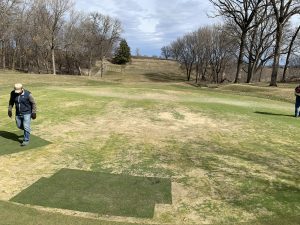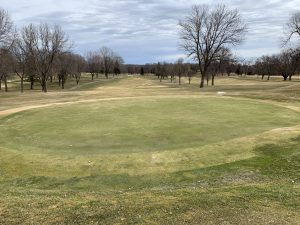Starting To Warm Up
Are Covers The Answer?
For some winters covers will definitely help the greens overwinter in good shape, for other winters it doesn’t matter if they are covered because the winter wasn’t damaging, and then there are winters like the one we just had and even under covers there is damage. Based on past history with covers and no covers we have continued to cover 7 & 16 greens.

#16 green after covers removed and cleanup taking place.
Those two greens always had some damage when not covered over winter, but the rest of the golf course fared very well. In 2011 we lost a significant amount of the front of 16 green, and in 2013 we had significant damage on 7 & 16 greens. It’s not uncommon to see some poa annua damaged from the winter, but typically it’s not widespread and easily recovered without closing areas of the golf course. As we move forward we will continue to evaluate covering and covering more of the greens in an effort to protect our greens from winter injury because regardless of their variability they will almost always help the turf over winter. Covers however are not a silver bullet and that was very much proven this past winter across our region. Many of the courses that grow poa annua and cover greens, regardless of the covering method, have suffered some form of damage this winter.
Bentgrass Is The Clear Winner
In our region bentgrass is clearly the choice for winter hardiness on a golf course. You can still have damage on bent, winters can just be that problematic, but after the winter we just went through with rains, freezes, thaws, and ice there is a clear winner in turf and it’s bentgrass.

#18 green – Was uncovered but is predominantly bentgrass and full sun.
Our management practices over the years have always been to promote bentgrass, from chemical strategies to tree removal. But when greens have a predominant amount of poa annua on them you have to also try and not set that back too much because its the major turf on a particular green. Without wholesale re-grassing we have to continue to grow the poa we have along with the bent. As we look into more cover options we will also investigate re-grassing strategies and have that as one more option moving forward. As part of that consideration however, there is much more tree removal around our green complexes that would need to be done to give the bentgrass the best chance of dominance.
Best Management Practices
We will continue to follow and evaluate best management practices for strong turf systems. Fertilizer programs, topdressing schedules during summer and pre-winter, drainage systems, shade management, aerification processes, soil testing and modification, and all the other various inputs and mower set-up that contributes to healthy turf plants. You’ll definitely be hearing more about the covering options and re-grassing scenarios as we move forward and compile more detailed information. So stay tuned for that and more from around the course here on the blog.

